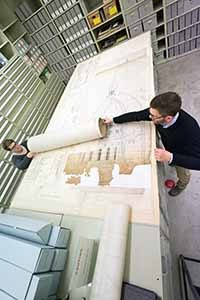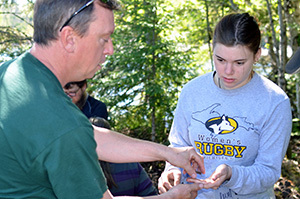Michigan’s cultural treasures – preserved, protected, cared for and shared by the DNR
By SUZANNE FISCHER
Michigan Department of Natural Resources

Most people already know that the Michigan Department of Natural Resources manages elk herds and stands of pine – but how about historic photos, a 1957 Corvette and a historic fort on the Keweenaw Peninsula?
All these things are part of Michigan’s cultural resources, also managed by the DNR.
For more than a decade, the DNR has committed in its mission to preserving, protecting, stewarding, and sharing cultural resources – as well as natural resources – for the people of Michigan.
“Cultural resources are the state’s treasures that were made by people in Michigan and are evidence of their lives and stories,” said Sandra Clark, director of the Michigan History Center in Lansing. “Like natural resources, they are held in trust by the DNR for the people of Michigan, to make sure that the state’s history and culture are documented, preserved and shared.”
Cultural resources give lives meaning. They’re the things that tell stories of who we were and how and why and where we live and lived. They’re historic houses, stores, offices, sawmills and blast furnaces.
“Cultural resources, like the Sanilac Petroglyphs in Sanilac County, are gifts from Michigan’s first peoples to their current descendants,” said Stacy Tchorzynski, archaeologist with the State Historic Preservation Office. “They’re tools and ceramics uncovered to help reconstruct a community’s daily life.”
|

They’re objects, tens of thousands of them – from Civil War rifles and satellite dishes to lead service pipes from Flint – that tell stories of our state.
“Cultural resources include millions of records of the births, deaths, naturalization, imprisonment and freedom of Michigan’s people,” said state archivist Mark Harvey. “They’re the official records of state and local government and the hand-written diaries and letters of famous and everyday people.”
Cultural resources are images of Michigan, the historic photos that allow us to see into the past.
Several DNR divisions manage Michigan’s cultural resources.
The Michigan History Center takes care of, and provides access to, the state’s historic objects, documents and photographs. Within the center, the Michigan History Museum collects artifacts that relate to the history, culture and people of Michigan.
“These collections include more than 130,000 artifacts ranging from farm tools to elegant 19th-century textiles and streamlined 20th-century automobiles,” Clark said.
|

The Archives of Michigan is responsible for preserving the records of Michigan government and other public institutions. With documents dating back to 1792, the archives house much of Michigan's recorded heritage.
“We have more than 120 million state and local government records and private papers, 10 million photographs and 50,000 maps, plus films and audio tapes are available for research,” Harvey said.
The Michigan History Center collaborates with the DNR’s Parks and Recreation Division to interpret and preserve historic sites at eight state parks in Michigan.
Among these sites are Fayette Historic State Park in Delta County, with its astonishingly complete 19th-century iron-processing company townsite located on the Garden Peninsula; Cambridge Junction State Park in Lenawee County, home to the historic Walker Tavern; and Fort Wilkins Historic State Park, a site in Copper Harbor at the tip of the Keweenaw Peninsula that dates back to the days of the mid-1840s Copper Rush.
Friends groups associated with the historic state parks collaborate with the Michigan History Center and the DNR to preserve and share these one-of-a-kind cultural resources with a broad public.
“The DNR is not only responsible for managing the state’s great natural resources, but also many of the state’s unique cultural resources,” said Bob Wild, park supervisor at Fort Wilkins Historic State Park in Copper Harbor. “Partnering with entities like friends groups and the Michigan Historical Center helps the DNR to best preserve these wonderful cultural treasures.”
|

The DNR’s Parks and Recreation Division’s Stewardship Unit also manages cultural resources found within Michigan’s 103 state parks, from Fresnel lenses in Michigan’s historic lighthouses to historic structures of all kinds.
Even a state park toilet-shower building can be a cultural resource. During in the 1930s and 40s, enrollees in the Civilian Conservation Corps built a great deal of state park infrastructure in Michigan, including roads and bridges, picnic pavilions and decorative stone walls and gates – like the ones at Bewabic State Park in Iron County – and these historic toilet-shower buildings.
Mackinac State Historic Parks, another DNR division, manages historic sites, structures and objects relating to the history of the Straits of Mackinac on Mackinac Island and in Mackinaw City.
The state’s buried cultural resources, the archaeological evidence of people’s lives as seen in pottery, fire-cracked rock and bottles of medicine, are managed by the Office of the State Archaeologist, housed in the State Historic Preservation Office at the Michigan State Housing Development Authority.
This office manages objects found in the ground as well as objects found underwater, on the “bottomlands” of the Great Lakes, where shipwrecks have come to rest. The Center partners with the National Oceanic and Atmospheric Administration in managing the Thunder Bay National Marine Sanctuary in Alpena.
While cultural resources may not be the first thing many people think of when they think of the DNR, the department’s role as steward of our cultural heritage cannot be diminished.
From photographs and maps to personal records, historic forts and sunken ships, Michigan’s cultural treasures are the ingredients that help people and communities find, learn and share their own stories.
Get more information on Michigan’s cultural resources at Michigan.gov/MHC.
|
Check out previous Showcasing the DNR stories in our archive at Michigan.gov/DNRStories. To subscribe to upcoming Showcasing articles, sign up for free email delivery at Michigan.gov/DNR.
/Note to editors: Contact: John Pepin, Showcasing the DNR series editor, 906-226-1352. Accompanying photos and a text-only version of this story are available below for download. Caption information follows. Credit Michigan Department of Natural Resources, unless otherwise noted.
Text-only version of this story.
Archives: State Archivist Mark Harvey and archivist Andrea Gietzen pull several of the original architectural drawings of the state's capitol for scanning.
Archives 2: With documents dating back to 1792, the Archives of Michigan holds a vast selection of historical documents ranging from the original blueprints and architect’s drawings of the Michigan capitol to the papers of former state legislators to naturalization records from the turn of the century to more personal collections. Pictured here is archivist Bob Garrett.
Artifacts: Artifacts recovered and displayed at Fort Wilkins Historic State Park help park visitors gain a deeper understanding of the history of the former military post.
Corvette: This Corvette, part of the Michigan History Center’s collections, is on permanent display at the Michigan History Museum in Lansing.
Fort: Reenactors help interpret cultural events for visitors at Fort Wilkins State Historic Park in Keweenaw County.
Guide: A lighthouse guide at Tawas Park State Park in Iosco County points out a feature to a couple of young park visitors. Lighthouses are among Michigan’s cultural resources.
Logs: This 1893 image of a World’s Fair load of pine logs – 31,800 board feet – is one of 10 million photographs in the Archives of Michigan’s holdings.
Pottery: Barry James, a historian with the Michigan History Center, Michigan Iron Industry Museum hands a piece of pottery to a Michigan Technological University student on an archaeological dig in the Upper Peninsula.
Townsite: The historic townsite at Fayette Historic State Park in Delta County is a remarkable place to visit, one of the many cultural resources managed by the Michigan Department of Natural Resources.
Walker: Archaeologists with the State Historic Preservation Office train museum visitors how to conduct an archaeological dig at Cambridge Junction Historic State Park. They are looking for artifacts related to Walker Tavern, the 19th-century stagecoach inn pictured in the background./
|